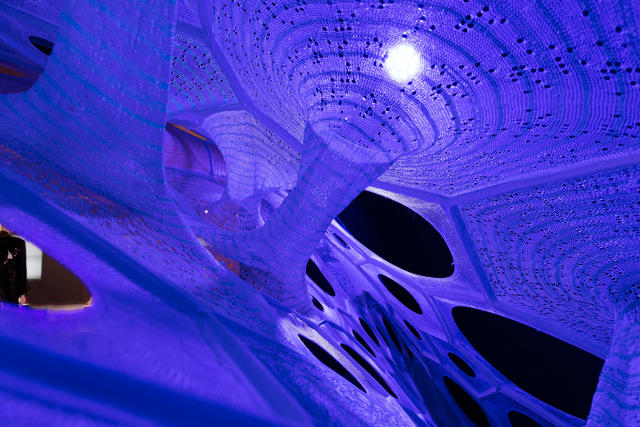As a generative designer, Jenny Sabin doesn't go into a project knowing exactly what's going to come out of it. She's more interested in the materials and math that go into creating a sculpture than in its final form. What's amazing about her art is that the final form never feels like an afterthought.
Case in point? Sabin's latest, a pulsing, light-absorbing pavilion that looks like a web from an alien world. On display at New York's Cooper Hewitt as part of the fifth installment of the museum's Design Triennial, it's big enough for 20 people to stand under, yet light enough for a single person to lift.

According to Sabin, the Polythread Knitted Textile Pavilion was inspired by her fascination with minimal surfaces: The branch of mathematics devoted to geometries that have the smallest surface area possible. A kite's a good example of a minimal surface; so is the iridescent film on a coat hanger dipped into soapy water. She wanted to see if there was a way for her to create an entire structure that was describable through minimal surfaces.
At the same time, she was interested in creating a large fabric structure that was fully integrated. In other words, even though the pavilion contains an armature, the skeleton isn't what defines the finished structure's shape. It's supported by the approximately 100 pounds of fabric threaded through the armature, and vice versa.

To design her Textile Pavilion, Sabin started by choosing her materials—twill tape, aluminum tubing, then both photo-luminescent and light-activated yarns. Using a series of computer models, Sabin generated her design parametrically, or by playing with parameters and letting the computer do the rest. Once the finished design was settled on, Sabin used 3-D printers to mock it up as a scale model, before outsourcing the armature and knit fabric for production. It was then brought to the Cooper Hewitt for assembly.
What makes the Polythread Knitted Textile Pavilion so special, though, is the way it emits light. The fabric shell of the pavilion is made up of both photo-luminescent and light-activated yarns. In other words, half of the pavilion glows in the light, and half of it glows in the dark. The result is a beautifully eerie effect in which the skin of the pavilion is constantly reacting to itself, something which Sabin highlight at the Cooper Hewitt through a simulated day-night cycle every 20 minutes.
Although her Pavilion is stuck inside the Cooper Hewitt for now, Sabin says she eventually hopes that a similar structure can be erected on a permanent basis outdoors. In the meantime, it will be on exhibit until August 21.
All Images: via Cooper Hewitt